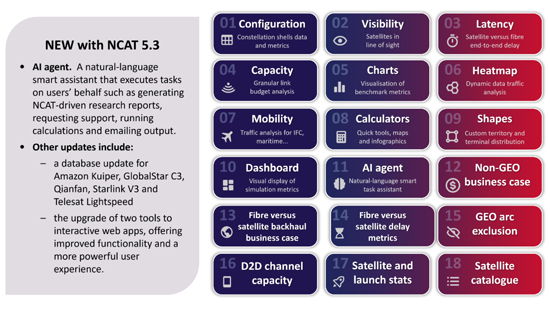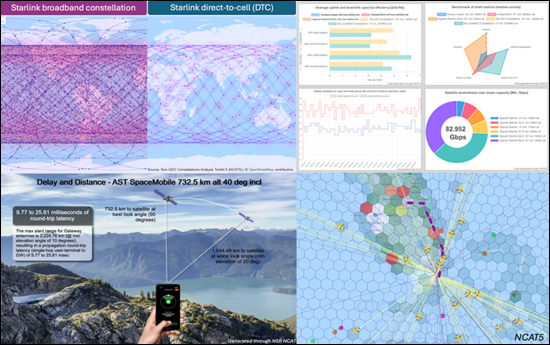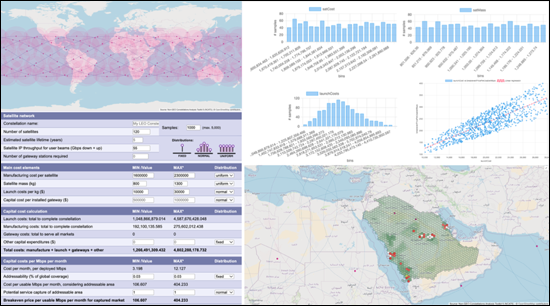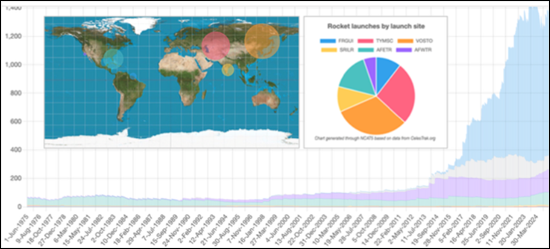|
年間契約型資訊服務
商品編碼
1765469
非GEO衛星星系分析Toolkit 5.3Non-GEO Constellations Analysis Toolkit 5.3 |
|||||||
非地球靜止軌道 (GEO) 衛星星座分析工具包 (NCAT) 將嚴謹的資料驅動分析與直覺的使用者體驗結合,對低地球軌道 (LEO) 和中地球軌道 (MEO) 衛星星座進行客觀評估。

NCAT 透過整合多樣化資料集、進階分析、互動式視覺化和人工智慧 (AI) 功能,為策略家、商業領袖和技術專業人士提供有關非地球靜止軌道 (non-GEO) 衛星星座能力和影響的可靠洞察。
NCAT 是一款用戶友好的線上 Web 應用程序,可讓您直觀地了解頻寬供需趨勢、評估市場可尋址性並驗證業務案例敏感性。它還可以對衛星相關數據和發射統計數據進行詳細分析。
NCAT 自動計算關鍵效能指標,並根據衛星星座之間以及與地面網路之間的差異進行基準測試。所有這一切都無需任何技術專業知識。
覆蓋範圍
基於數萬行原始程式碼和數百萬筆可查詢資料庫記錄,18 個整合工具可提供客觀的、資料驅動的衛星星座效能多層次評估。數百萬次動態計算透過直覺的介面進行處理,該介面具有可配置的過濾器、可視化控制項和使用者定義的輸入。所有輸出資料(資料表、圖表、視覺化)均可輕鬆下載,以便進一步分析和報告。

特徵
- 嚴謹的編碼演算法提供基於事實的分析和視覺化。
- 全面且定期更新的資料庫。運行最新的模擬。
- 每日更新:在軌衛星數量和軌道觀測數據
- 每週更新(週日):衛星目錄
- 每月更新:衛星和發射統計數據
- 季度更新:核心軟體與資料庫增強功能
- 點擊式互動:輕鬆導航互動式地圖和控制項(圖層、篩選器、按鈕、設定等),只需點擊幾下即可放大和縮小、定位裝置以及執行動態計算和視覺化。
- 多軌道、多頻段分析:可跨越一個或多個系統的軌道層組合設定模擬,從而同時計算不同頻段的數千顆衛星。
- 動態動畫顯示:顯示關鍵條件的即時傳播,包括衛星位置、覆蓋範圍、可見衛星、天線視角、鏈路延遲變化以及供需熱圖。
- 時空控制:NCAT5 支援全球、區域和本地尺度的即時和加速延時分析。模擬速度最高可提高 300 倍,可在約 5 分鐘內分析一天的星座表現。
- 六邊形地面網格:NCAT5 採用動態六邊形網格,精度達到國家級,解析度可配置至城市級(蜂巢半徑 9 公里)。 Shapes 工具可讓您自訂區域,範圍超出 NCAT 資料庫中預先註冊的 250 多個國家和地區。
- 同步 IP 吞吐量運算:NCAT5 會同時對所有使用者和閘道波束執行連結預算吞吐量分析,同時考慮使用者終端和閘道視角的組合。
- 靈活的需求模型:您可以從預先定義的需求標準中進行選擇,也可以定義自訂需求參數(包括使用者終端分佈和頻寬需求的功能推動因素),以便根據特定用例自訂模擬。
- 需求驅動的供應:NCAT 根據可選的公平性標準模擬可控波束容量的動態重新配置,以使可行的供應與不斷變化的需求條件最佳匹配。
- 行動工具:NCAT 透過使用者定義的時間表支援各種行動應用(例如機上 Wi-Fi、鐵路、海事、連網汽車)。此外,NCAT 整合了涵蓋數萬條航線、航空公司和機場的即時商業航班數據,以評估機上連接 (IFC) 的供需動態。
- 統計數據:NCAT5 存取並處理全面的目錄數據和衛星發射統計數據,為用戶提供可配置的篩選器,用於搜尋自 1957 年以來發射到太空的超過 61,000 個未分類物體的數據。
- 報告:AI 代理工具使用自然語言與 NCAT 內部的工具和資料集無縫交互,以回答查詢、建立專業報告並解釋模擬結果。
- 可下載的圖表和資料:所有圖表、地圖和資訊圖表均可下載為 PDF 或 PNG 格式。輸出資料以表格 CSV 格式提供,以便在平台外部進行進一步分析。可下載的內容包括表格、圖表資料、地圖、基準指標、帶有時間戳記的樣本、包含供需資料的地面網格、評估摘要、飛行路線、視角統計資料、波束利用率等。
應用 |
NCAT 專注於衛星通訊 (satcom),但也具備評估地球觀測 (EO) 和全球導航衛星系統 (GNSS) 的能力。 |
工具 |
18 種可設定工具可進行多維分析和基準測試,例如:
|
星座框架: |
100 多個已運作、已規劃和已提交的系統,使用者可編輯和擴展 |
網關: |
超過 370 個已勘測的網關位置(使用者可編輯和擴充) |
地理區域: |
涵蓋超過 250 個國家、地區、區域和子區域(使用者可編輯和擴展) |

常見問題
- 覆蓋範圍、容量和波束是多少當前和未來 NGSO 架構的地面和衛星基準是什麼?
- 每個網關、用戶波束和衛星的前向和反向鏈路容量(頻譜、頻寬、IP 吞吐量)是多少?
- 每個國家可以支援多少個並髮用戶?
- 如何決定每兆位元每秒的資本成本?
- 商業案例對太空船製造和發射成本的敏感度如何?
- 在哪些情況下,衛星星座在服務不足地區的表現會優於光纖?
- 回程資本支出與固定成本如何影響商業案例?
- 如何根據可設定的服務計畫評估頻寬供需?擁塞熱點在哪裡?
- 不同緯度和軌道層的最大、平均和最小衛星數量是多少?
- 考慮到POP、光學星間鏈路 (OISL) 和鏈路中繼,光纖延遲與LEO系統相比如何?
- 非GEO系統應採用哪些排除角來避免GEO幹擾?


此工具的目標使用者:
- 衛星營運商(GEO、非GEO、FSS、MSS/D2D)
- 衛星製造商和組件供應商
- 地面/無線網路營運商(電信營運商、行動網路營運商、網際網路服務供應商、鐵塔營運商、雲端服務供應商等)
- 地面系統供應商(終端、天線、集線器/數據機、SD-WAN)
- 電信港營運商、衛星服務供應商、GEO-非GEO整合商
- 主要非GEO容量使用者(政府、國防、航空公司、能源公司等)
- 產業協會、研究機構與研究組織
- 開發虛擬星座軟體的IT公司
- 監管機構與頻率研究組織
- 金融機構、投資公司
包含的衛星系統(案例)
|
|
NCAT 是一款可在線配置的工具集,包含無限制使用,並預裝了主要許可、運營和計劃中的非地球靜止軌道衛星系統的數據集。
The 'Non-GEO Constellations Analysis Toolkit (NCAT)' combines rigorous, data-driven analysis with an intuitive user experience to deliver objective assessments of low-Earth orbit (LEO) and medium-Earth orbit (MEO) satellite constellations.

NCAT equips strategists, business leaders and technical professionals with reliable insights into the capabilities and impact of non-geostationary (non-GEO) constellations by integrating diverse datasets, advanced analytics, interactive visualisations and AI capabilities.
NCAT is delivered as a user-friendly online web app, and empowers users to seamlessly explore bandwidth supply and demand dynamics, assess market addressability, evaluate business case sensitivities and delve into satellite data and launch statistics. The platform automatically calculates key performance metrics and benchmarks the competitiveness of satellite constellations (both against each other and relative to terrestrial networks), all without requiring deep technical expertise.
Toolkit coverage
18 integrated tools, driven by tens of thousands of lines of original code and millions of queryable database records, provide objective, data-driven assessments of constellation performance at multiple levels. Millions of dynamic calculations are processed via an intuitive interface with configurable filters, visualisation controls and user-defined inputs. All outputs (data tables, charts and visualisations) are easily downloadable for further analysis or reporting.

Features included:
- Rigorously coded algorithms that drive factual analytics and visualisations.
- A comprehensive, regularly updated database. This enables users to run up-to-date simulations.
- Daily: in-orbit satellite counts and orbital observations are updated automatically every day.
- Weekly: the satellite catalogue is updated automatically each Sunday.
- Monthly: satellite and launch statistics are refreshed automatically every month.
- quarterly: core software and database enhancements are deployed every quarter.
- Point-and-click interactivity. Users can easily navigate interactive maps and controls (such as layers, filters, buttons and settings) to zoom in and out, set user terminal locations and drive dynamic calculations and visualisations with just a few clicks.
- Multi-orbit, multi-band analysis. Simulations can be configured across combinations of orbital shells from one or multiple systems, thus enabling concurrent calculations for thousands of satellites across different frequency bands.
- Dynamic, animated visualisations. Users can view real-time propagation of key conditions, including satellite positions, coverage footprints, visible satellites, antenna look angles, link latency variations and supply-demand heatmaps.
- Space-time controls. NCAT5 supports both real-time and accelerated time-lapse analysis at global, regional or local scales. Simulations can be sped up by up to 300x, enabling users to analyse a full day of constellation performance in around 5 minutes.
- Hexagonal ground grid. NCAT5 employs a dynamic hexagonal grid with country-level precision, configurable down to city-scale resolution (~9 km cell radius). The 'Shapes' tool enables users to define custom geographical areas beyond the 250+ countries and regions preloaded in the NCAT database.
- Concurrent IP throughput computations. NCAT5 performs concurrent link-budget throughput analysis across all user and gateway beams, accounting for combinations of user-terminal and gateway look angles.
- Flexible demand models. The toolset enables users to choose from pre-set demand criteria or define custom demand parameters (including user terminal distribution and functional drivers of bandwidth demand) to tailor simulations to specific use cases.
- Demand-driven supply. NCAT simulates dynamic reconfigurations of steerable beam capacity based on selectable fairness criteria to optimally match feasible supply with changing demand conditions.
- Mobility tool. NCAT supports a wide range of mobility applications (such as in-flight Wi-Fi, rail, maritime and connected vehicles) through user-defined schedules. Additionally, NCAT integrates real-time commercial flight data, covering tens of thousands of routes, airlines and airports, to assess in-flight connectivity (IFC) supply and demand dynamics.
- Statistics. NCAT5 accesses and processes comprehensive catalogued data and satellite launch statistics, presenting users with configurable filters to explore data for over 61 000 unclassified objects launched into space since 1957.
- Report generation. The AI Agent tool uses natural language to interact seamlessly with internal NCAT tools and datasets, enabling it to answer queries, generate professional reports and interpret simulation results.
- Downloadable charts and data. All charts, maps and infographics can be downloaded in PDF or PNG format. Output data is available in tabular CSV format, enabling further analysis outside the platform. Downloadable content includes tables, chart data, maps, benchmark metrics, time-stamped samples, terrestrial grids with supply and demand data, assessment summaries, flight routes, look angle statistics, beam utilisation and more.
Applications: |
NCAT is focused on satellite communications (satcom) but includes features to assess Earth observation (EO) and global navigation satellite systems (GNSS). |
Tools: |
18 configurable tools to analyse and benchmark systems from multiple angles, including:
|
Constellation shells: |
100+ operational, planned and filed systems included (user editable and expandable). |
Gateways: |
370+ surveyed gateway locations (user editable and expandable). |
Geographical regions: |
250+ countries, territories, regions and subregions included (user editable and expandable). |

Questions answered:
- How do current and future NGSO architectures benchmark across coverage, capacity, beam, and satellites?
- What is the forward and return link capacity (spectrum, bandwidth and IP throughput) per gateway, user beam and satellite?
- How many users can constellations support simultaneously, by country or territory?
- How can the capital cost per usable megabits per second be determined?
- What is the business-case sensitivity to spacecraft manufacturing and launch costs?
- When can satcom constellations outperform fibre-optics in underserved communities?
- How does backhaul capex and opex affect the business case?
- How can bandwidth supply and demand be assessed, based on configurable service plans, and where are the congestion hotspots?
- What is the maximum, average and minimum number of satellites in view or line of sight at different latitudes and orbital shells?
- How does fibre latency compare with that of LEO systems, factoring in POPs, optical inter-satellite links (OISLs) and link relays?
- What are the regulatory exclusion angles for non-GEO systems to avoid GEO interference?


Who should use this toolbox:
- Satellite operators (GEO, non-GEO, FSS and MSS/D2D)
- Spacecraft manufacturers and component vendors
- Terrestrial/wireless network operators (telecoms operators, MNOs, ISPs, towercos, cloud services providers and so on)
- Ground system vendors (terminals, antennas, hub/modems and SD-WAN)
- Teleport operators, satellite service providers and GEO-non-GEO integrators
- Major non-GEO capacity users (such as governments, defence players, airlines and energy companies)
- Industry associations, research labs and institutions
- IT companies developing virtualised constellation software
- Regulators and spectrum research agencies
- Financial institutions and investment firms
Satellite systems included (examples):
|
|
As an online configurable toolset, NCAT has unlimited usability and is delivered pre-populated with datasets for leading non-GEO systems, including granted, operating and proposed systems.




